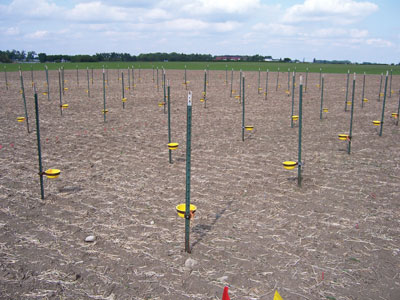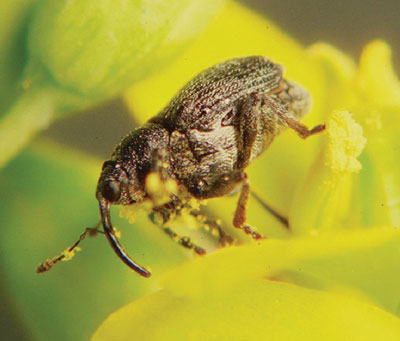
Features
Agronomy
Other Crops
Searching for IPM strategies for cabbage seedpod weevil
At present, insecticides are about the only option for producers to control the cabbage seedpod weevil, an important pest of canola.
March 17, 2009 By Carolyn King
At present, insecticides are about the only option for producers to control the cabbage seedpod weevil, an important pest of canola. So a group of University of Alberta researchers is investigating a wide range of cultural, biological and chemical options to develop an integrated pest management strategy to control the weevil. James Tansey is one of these researchers, and he is tackling the problem from the weevil’s point
of view.
 |
|
| Early season experimental setup to trap cabbage seedpod weevils in field trials of intercropped weevil-resistant and weevil-susceptible lines. Photo courtesy of James Tansey. |
The research program, led by Dr. Lloyd Dosdall, has, as a key component, the development of a weevil-resistant, commercially available canola cultivar. As part of that, the researchers have been working with weevil-resistant crosses of yellow mustard Sinapus alba and Argentine canola Brassica napus. Tansey, a PhD candidate, is exploring how the weevil-resistant genotypes manage to repel the weevil. His research is funded by the Canola Council of Canada and Natural Sciences and Engineering Research Council of Canada.
An invasive pest
Adult cabbage seedpod weevils are grey, about three to four millimetres long and have a pronounced snout. This invasive weevil was introduced to North America from Europe in 1931. Tansey says, “The weevil worked its way to the Lethbridge area by 1995 and has since spread into Saskatchewan and as far north as the Red Deer area as of 2007, and I caught one in the Edmonton area in 2008.”
 |
|
| A close-up of a cabbage seedpod weevil. Photo courtesy of Dr. Lloyd Dosdall. |
He notes, “In southern Alberta the cabbage seedpod weevil is a tremendous problem. The populations are very high. As far as actual economic damage associated with this beetle, there aren’t really any current estimates.” The weevils can be monitored by taking sweep net samples during the bud and flowering stages. Tansey says, “Economic thresholds for implementing control measures have been reduced from about four weevils per sweep to roughly two per sweep, based on increasing canola prices.”
The weevil damages canola plants in several ways. “Adult feeding on the developing flowers will cause bud blasting, so it can cause abortion of the flowers. The adults will also chew a little hole into the developing canola pods and lay their eggs inside. The holes themselves can offer avenues for fungal pathogens, thrips or other small organisms to enter the pod, which can cause further problems,” explains Tansey. “The larvae hatch inside the pod. You can find as many as five or six larvae per pod, though these instances are relatively rare; each larva is capable of eating about five seeds. The larvae also reduce the quality of the remaining seeds, and cause the pod to be more subject to shatter. When they’ve finished their larval development, they chew their way out of the pod, creating more holes. Then they fall to the ground and pupate in the soil. The adult comes up in late summer, and it feeds on the canola pods, causing further damage.”
Many angles on weevil behaviour
Tansey’s research is showing that the weevil-resistant genotypes seem to have a number of ways to discourage the weevil from feeding and laying eggs on the plants.
One resistance strategy seems to be the plant’s odour. In his experiments to date, he has found that the smell of the resistant genotypes is significantly less attractive to the weevil than the smell of Argentine canola. “We are looking at some differences in the headspace volatiles, the actual individual chemical compounds that are exuded by the genotypes, to see how this influences the weevil’s feeding preference and host choice. So if the plant doesn’t quite smell like food or one plant smells better than the other, then the weevil will go to the one that smells better, more like food. The difference could be something as subtle as the proportion of various compounds,” says Tansey.
Tansey is also exploring visual cues that might influence weevil behaviour. So far he has assessed the differences between how the flowers on the weevil-resistant and weevil-susceptible plants reflect near-ultraviolet light. He says there are significant differences among the various genotypes in the appeal of the visual cues of the flowers. There seems to be a pretty good link between the plant’s susceptibility and its visual attractiveness to the weevils. Next, Tansey will be doing photographic analysis to see if the flowers of the resistant and susceptible plants have differing visual patterns in the near-ultraviolet part of the spectrum.
Another angle he’s examining is antibiosis, a relationship between two organisms in which one is adversely affected. Tansey says antibiosis can be an important factor in delaying the weevil’s larval development and reducing larval weights in resistant pods. “The longer you can keep a weevil larva around, the greater the chance it will be exposed to a parasitoid and a predator.” He is investigating what traits contribute
to antibiosis.
Tansey is also involved in assessing the effects of intercropping weevil-resistant and susceptible plants. In these field trials, the intercropped plots had fewer weevils than the monoculture weevil-susceptible plots, as expected. More surprisingly, the intercrops had fewer weevils than the monoculture weevil-resistant plots during one sampling date.
Intercropping susceptible and resistant plants offers a couple of possible benefits for weevil control. Tansey explains, “If you expose the insect to a resistant trait for a long period of time, there’s greater selective pressure for the insect to overcome that resistance. But if you include a susceptible refuge, that reduces the selective pressure.” He adds, “Another thought about the effects of intercropping, and I have some data to show that this may very well be happening, is that it causes a bit of confusion in the insect population. So they spend more time choosing than laying eggs and feeding.”
Yet another component of the research program is to evaluate how climatic factors influence the spread of cabbage seedpod weevils. “The weevils seem to be moving at about 55 to 60 km a year in their invasion of western Canada through Saskatchewan. We have some traps at six metres above the ground, and we’re doing analysis of different climatological factors week by week in relation to the trap catches, in an attempt to model their distribution based on climatological factors as they might be influenced by global climate change. Mean maximum temperatures and relative humidity seem to affect their movement, so as the climate warms, the weevil’s potential for moving further and faster increases dramatically, and as the climate becomes drier, they seem to move farther.”
These diverse investigations of the cabbage seedpod weevil’s behaviour are all contributing to development of an integrated pest management strategy. Tansey says that using an integrated pest management strategy helps to reduce of the use of pesticides. That is important, especially with the reduction in economic thresholds associated with higher canola prices, which puts more pressure on the producer to spray.